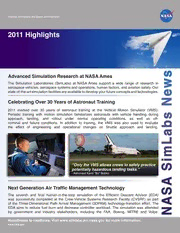
NASA Technical Reports Server (NTRS) 20160000318: 2011 Highlights: Advanced Simulation Research at NASA Ames PDF
Preview NASA Technical Reports Server (NTRS) 20160000318: 2011 Highlights: Advanced Simulation Research at NASA Ames
National Aeronautics and Space Administration 2011 Highlights s Advanced Simulation Research at NASA Ames w The Simulation Laboratories (SimLabs) at NASA Ames support a wide range of research in aerospace vehicles, aerospace systems and operations, human factors, and aviation safety. Our e state-of-the-art simulation facilities are available to develop your future concepts and technologies. N Celebrating Over 30 Years of Astronaut Training 2011 marked over 30 years of astronaut training at the Vertical Motion Simulator (VMS). s Periodic training with motion simulation familiarizes astronauts with vehicle handling during approach, landing, and rollout under normal operating conditions, as well as off- b nominal and failure conditions. In addition to training, the VMS was also used to evaluate the effect of engineering and operational changes on Shuttle approach and landing. a L m i S “Only the VMS allows crews to safely practice potentially hazardous landing tasks.” - Astronaut Karol “Bo” Bobko A Next Generation Air Traffic Management Technology S The seventh and final human-in-the-loop simulation of the Efficient Descent Advisor (EDA) A was successfully completed at the Crew-Vehicle Systems Research Facility (CVSRF) as part of the Three-Dimensional Path Arrival Management (3DPAM) technology-transition effort. The EDA aims to reduce fuel burn and decrease controller workload. The simulation was attended N by government and industry stakeholders, including the FAA, Boeing, MITRE and Volpe. Hypotheses to headlines. Visit www.simlabs.arc.nasa.gov for more information. www.nasa.gov SimLabs: 2011 News Highlights FutureFlight Central (FFC) Vertical Motion Simulator (VMS) The FFC facility offers immersive, 360-degree, full-scale, real- The VMS provides researchers with advanced tools to explore, time simulation capability with a customizable, modular layout. define, and solve issues in aircraft and spacecraft design. SARDA: The Spot And Runway Departure Advisor (SARDA) LCTR: Collaborative NASA/US Army studies of the Large Civil research team continues with algorithmic, human factors, Tilt-Rotor (LCTR) continued on the VMS to investigate flight and simulator enhancements in preparation for testing in control design and handling quality issues of large (similar in FY2012. The SARDA airport scheduler consists of two tools size to a Boeing 737) tilt-rotor aircraft. Modified rotorcraft handling that provide efficient taxi advisories. The Spot Release Plan- quality tasks were used to develop the flight control systems ner (SRP) aims to reduce taxi delay from the spot to the that will enable the LCTR to help revolutionize civilian air travel. departure queue, and provides sequence and timing advisories to the ground controller. The Runway Scheduler CAPIO: A NASA-developed Control Allocation for (RS) maximizes runway usage and displays advisories the reduction of Pilot-Induced Oscillation (CAPIO) to the local controller, knitting departures with arrival controller was tested at the VMS in FY2011. runway-crossing traffic. Algorithmic changes Seven experienced test pilots evaluated the include scheduling refinement to arrival traffic. system in a total of 647 data runs, using Human factors research looks at designing maneuvers designed to expose any Pilot the user interface, allowing controllers to Induced Oscillation (PIO) tendencies interact with the scheduler. Simulator in the system in a controlled and upgrades include integration with repeatable manner. The CAPIO the FFC’s 360-degree tower controller exhibited the potential simulator and the use of elec- to greatly reduce PIO tronic flight strips contain- tendencies in aircraft with ing SARDA advisories. rate-limited actuators. Crew-Vehicle Systems Research Facility (CVSRF) Air Traffic Management Labs (ATM) The CVSRF’s high-fidelity flight simulators offer full-mission Our ATM Labs provide state-of-the-art tools to research and capability for human factors & aerospace operations research. develop current and futuristic air traffic management concepts. TBAS: Two simulation studies were completed in FY2011 for TTSAFE: Conflict prediction in terminal airspace is chal- continued development of the Trajectory-Based Automation lenging due to complex separation standards, dense traffic, System (TBAS) that can enhance future air traffic safety and and limited flight plan data. Current tools rely on the use of efficiency through intelligent automation tools. The flight and dead reckoning without intent information, causing the tools air traffic control simulators at CVSRF were linked for human- to generate large numbers of false alerts. Two human-in- in-the-loop evaluations of a Trajectory-Based Operations the-loop experiments, simulating air traffic operations in the concept with mixed voice and datalink operations. Eight Southern California terminal radar approach control (TRA- experimental conditions were tested: four datalink levels CON), were conducted in FY2011 to evaluate a new ranging from 0% (voice only) to 80%, with two levels of conflict detection and resolution tool called Terminal traffic density. Weather avoidance advisories were Tactical Separation Assured Flight Environment also tested, and feedback on the feasibility of the (TTSAFE). ATM simulation facilities at SimLabs concept was positive from both pilots and con- were used to both collect data on TTSAFE’s trollers. One key finding was that controllers performance and assess the impact on con- issued significantly more time-saving troller workload. Using an algorithm that flight plan amendments under data- incorporates flight plans, departure link conditions than under voice- and arrival routes, speed restric- only conditions, amounting to tions, and altitude clearances, between five and twelve TTSAFE predicts conflicts minutes of flying time much more accurately savings per hour. than current tools. Visit www.simlabs.arc.nasa.gov for full articles.
